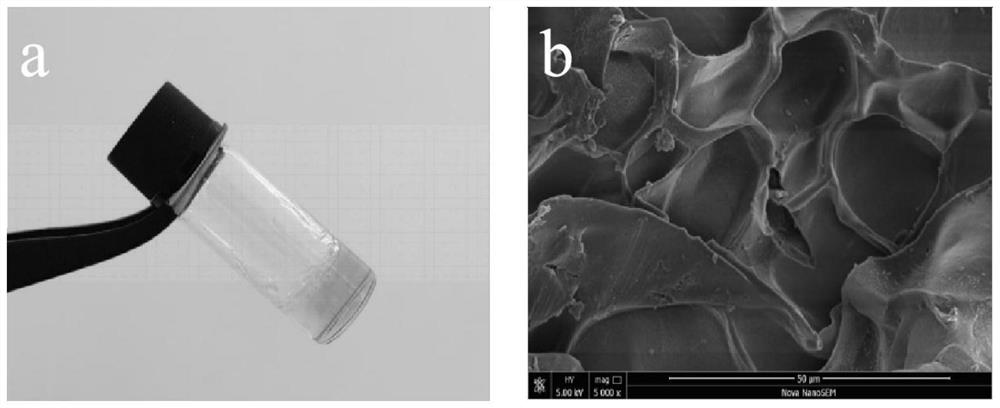CuS nanoparticle protein hydrogel and preparation method and application thereof
A nanoparticle and protein water technology, applied in the fields of biomedicine and polymer materials, can solve the problems of secondary wounds, affecting later activities, and limiting the preparation and application of self-healing hydrogels
- Summary
- Abstract
- Description
- Claims
- Application Information
AI Technical Summary
Problems solved by technology
Method used
Image
Examples
Embodiment 1
[0025] (1) Preparation of PBS-EDTA-2Na solution
[0026] Mix 600mg of phosphate buffer solution powder PBS and 93mg of ethylenediaminetetraacetic acid disodium EDTA-2Na powder and dissolve in 50mL of deionized water. After constant volume, adjust the pH value to 8.0 to configure PBS-EDTA-2Na solution .
[0027] (2) Synthesis of mercaptogelatin
[0028] Dissolve 1g of gelatin in 40mL of the PBS-EDTA-2Na solution obtained in step (1), in a hot water bath at 50°C until completely dissolved, then add 32mg of Traut's Reagent, and stir magnetically for 2-3 hours to make it After fully reacting, 10 mL of deionized water was added for dialysis for 5 to 7 days, and then freeze-dried to obtain a mercaptogelatin product.
[0029] (3) Preparation of aqueous solution of CuS nanoparticles
[0030] 17.8mg of CuCl 2 2H 2 O and 22.8 mg of sodium citrate were dissolved in 20 mL of deionized water and stirred magnetically for 5 minutes at room temperature. Then 24.0 mg of Na was added to t...
Embodiment 2
[0035] (1) Preparation of PBS-EDTA-2Na solution
[0036] Mix 600mg of phosphate buffer solution powder PBS and 93mg of ethylenediaminetetraacetic acid disodium EDTA-2Na powder and dissolve in 50mL of deionized water. After constant volume, adjust the pH value to 8.0 to configure PBS-EDTA-2Na solution .
[0037] (2) Synthesis of mercaptogelatin
[0038] Dissolve 1g of gelatin in 40mL of the PBS-EDTA-2Na solution obtained in step (1), in a hot water bath at 50°C until completely dissolved, then add 32mg of Traut's Reagent, and stir magnetically for 2-3 hours to make it After fully reacting, 10 mL of deionized water was added for dialysis for 5 to 7 days, and then freeze-dried to obtain a mercaptogelatin product.
[0039] (3) Preparation of aqueous solution of CuS nanoparticles
[0040] 17.8mg of CuCl 2 2H 2 O and 22.8 mg of sodium citrate were dissolved in 20 mL of deionized water and stirred magnetically for 5 minutes at room temperature. Then 24.0 mg of Na was added to t...
Embodiment 3
[0048] (1) Preparation of PBS-EDTA-2Na solution
[0049] Mix 600mg of phosphate buffer solution powder PBS and 93mg of ethylenediaminetetraacetic acid disodium EDTA-2Na powder and dissolve in 50mL of deionized water. After constant volume, adjust the pH value to 8.0 to configure PBS-EDTA-2Na solution .
[0050] (2) Synthesis of mercaptogelatin
[0051] Dissolve 1g of gelatin in 40mL of the PBS-EDTA-2Na solution obtained in step (1), in a hot water bath at 50°C until completely dissolved, then add 32mg of Traut's Reagent, and stir magnetically for 2-3 hours to make it After fully reacting, 10 mL of deionized water was added for dialysis for 5 to 7 days, and then freeze-dried to obtain a mercaptogelatin product.
[0052] (3) Preparation of aqueous solution of CuS nanoparticles
[0053] 17.8mg of CuCl 2 2H 2 O and 22.8 mg of sodium citrate were dissolved in 20 mL of deionized water and stirred magnetically for 5 minutes at room temperature. Then 24.0 mg of Na was added to t...
PUM
 Login to View More
Login to View More Abstract
Description
Claims
Application Information
 Login to View More
Login to View More - R&D
- Intellectual Property
- Life Sciences
- Materials
- Tech Scout
- Unparalleled Data Quality
- Higher Quality Content
- 60% Fewer Hallucinations
Browse by: Latest US Patents, China's latest patents, Technical Efficacy Thesaurus, Application Domain, Technology Topic, Popular Technical Reports.
© 2025 PatSnap. All rights reserved.Legal|Privacy policy|Modern Slavery Act Transparency Statement|Sitemap|About US| Contact US: help@patsnap.com



